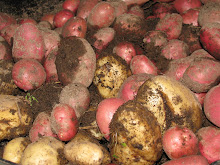But the maps provided something that the narrative and statistics lacked [...] We could articulate the case in words. [...] But when you’d put up the maps, they’d stop listening to you and look at them [as if to] say, ‘Is this really possible?’” Reed Colfax in an interview by Bob Burtman (water distribution example below)
There are a growing number of cases of Maptivism (Maps + Activism) around the world. I wrote about the great potential for engagement and transparency before. Although it is not a new method, it is certainly still quite different from the old school maps – because of the easiness to use digital maps. There are also more and more tools offered to either get geodata or to use existing data to visualize it more easily. GeoCommons is one such service for open geospatial data.
Western Africa
The West Africa Trade Hub, a USAID funded project did an interesting project. They questioned truck drivers in Western Africa about their experiences with checkpoints. The results were long delays and high bribes at region’s worst checkpoints (mapped below). A recent interview I did with Mark Davies indicated also some interesting insights from African trade and the potentials of social networks.
China
The China Real Time blog has highlighted an initiative by the Chinese blogger Guo Baofeng for a China Pollution Map:
“The chart (developed on Google Maps) allows viewers to mark spots associated with high levels of pollution or incidents of contamination, based on publicly available information. Since it was open for public participation last week, the number of views has more than doubled to about 5,000 compared to a week earlier, when it was first displayed online.”
Due to the recent move of Google to re-think its engagement in China, hopefully this map will not be censored any time soon.
(Hat tip to Giulio Quaggiotto)
USA
Bob Burtman highlights intriguing mapping work in his article by the Cedar Grove Institute for Sustainable Communities. Through surveys and public available data, they were able to produce the map below, which shows the partial distribution of water in city of Zanesville. Read the full article about fascinating ways to combine data and mapping.

Courtesy the Cedar Grove Institute for Sustainable Communities
Brazil
Mapping can be particularly helpful for community development. Corinne Ramey reports form a project to map slums in Brazil through mobile phones. “By uploading information to the phones, the reporters are mapping the unmapped, one road and cafe at a time.” Once places are mapped they can be used for multiple purposes

Courtesy of wikimapa.org.br
Kenya
A similar, but more extensive project has happened in the biggest informal area in Nairobi: Kibera. A team of mappers trained cohabitants of Kibera to map the largest slum in Africa.
Some of you probably know that I am particularly amazed about the OpenstreetMap project. Often, people ask me why we need such an open map, if we already have Google or Yahoo maps? Because it is not only about maps, but more importantly, about what we map and that we can use the data freely to use it the way it is needed. Or as Mikel Maron nicely puts it:”But the point is that with open source and open data, people everywhere don’t have to wait for Santa Google to gift them with new features ..”
When do you start mapping?
Mapping is really easy. I walk around in Mexico these days, during my free time and map streets and buildings with a GPS enabled mobile phone – a cheap GPS device is enough and costs under 100 Euro. That way you can already participate in tracking streets worldwide and upload them to OpenStreetMaps. Here is more information on how to participate.
Lastly, there is a great initiative by the tactical tech collective called Ten Tactics: “Exploring how rights advocates use information and digital technology to create positive change.”
http://www.crisscrossed.net/2010/01/15/5-innovative-examples-for-worldwide-maptivism/




No comments:
Post a Comment